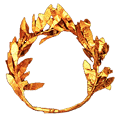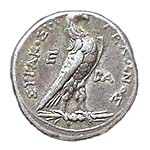![]() Introduction
Introduction
![]() Hiero II
Hiero II
![]() Philistis
Philistis
![]() Gelo II
Gelo II
![]() Hieronymos
Hieronymos

| Back to . . . |
This section . . .
|
 Gelo II (obverse)
Gelo II (obverse)
 Gelo II (reverse)
Gelo II (reverse)
|
GELO (or Gelon) was the son of Hiero and Philistis. He co-ruled with his father until his death c. 216 BC when he was over fifty years old. Hiero died about a year after Gelo and was succeeded by Gelo's fifteen-year-old son Hieronymos in 215 BC.
Gelo married Nereis, a daughter of Pyrrhos, the king of Epirus who briefly ruled over Syracuse c. 278-276 BC. In addition to Hieronymos they had a daughter, Harmonia. Hieronymos was assassinated in 214 BC, 13 months after his ascent to the throne, and Harmonia was put to death by an angry mob in the turmoil that followed.
Gelo's strong resemblance to his father is evident in the 4-litrai and 8-litrai silver coins that survive from his reign.
Archimedes addresses one of his more curious works, The Sand Reckoner, to Gelo. He begins with the line:
There are some, king Gelon, who think that the number of grains of sand is infinite.Archimedes then presents an estimate for the radius of the sphere of the fixed stars according to the wisdom of the day and estimates how many grains of sand would fit into that sphere. His purpose was to introduce a mathematical notation for arbitrarily large numbers--something that was missing in the clumsy notation used in his time. In his notation, the maximum number of grains of sand that could fit into the cosmos is "a thousand myriad units of the eighth order and first period." By this he means in modern notation
p108[(q-1) + (r-1)108]where
one myriad = 10,000Thus, the maximum number of grains of sands is
p = units = a thousand myriad = 10,000,000 = 107
q = order = 8
r = period = 1.
107108[(8-1) + (1-1)108] = 1071056 =1063.He concludes his work with the following lines:
I conceive, king Gelon, that these things will appear incredible to the numerous persons who have not studied mathematics; but to those who are conversant therewith and have given thought to the distances and the sizes of the earth, the sun, and the moon, and of the whole of the cosmos, the proof will carry conviction. It is for this reason that I thought it would not displease you either to consider these things.(Translation by C. Dikshoorn in E. J. Dijksterhuis' Archimedes, Princeton University Press, Princeton, New Jersey, 1987.)
PAUSANIAS (Description of Greece, [6.12.3])
On Gelo's marriage to Nereis:
This Hiero made an alliance with Pyrrhus the son of Aeacides, sealing it by the marriage of Gelo his son and Nereis the daughter of Pyrrhus.POLYBIUS (Universal History, Book VII.8)
Gelo, his [Hiero's] son, who lived to the age of over fifty, made it his highest object in life to obey his father and not to consider wealth or royal power or anything else as more valuable than affection and loyalty to his parents.LIVY (History of Rome from its Foundation, Book XXIII.30)
The same shift of feeling away from Rome spread as far as Sicily, where not even the house of Hiero was wholly free from disloyalty. Gelo, the eldest son, contemptuous, after Cannae [216 BC], of the Roman alliance and despising his father as a dotard, went over to the Carthaginian interest; and his action would have led to a rising, if, in the very act of arming the populace and trying to get support, he had not been carried off by a death so opportune that even his father did not escape suspicion.PROCLUS (A Commentary on the First Book of Euclid's Elements, Book II, Chapter III)
Tradition has it that Gelon made the same remark when, without destroying the crown that had been made, Archimedes discovered the weight of each of its component materials.